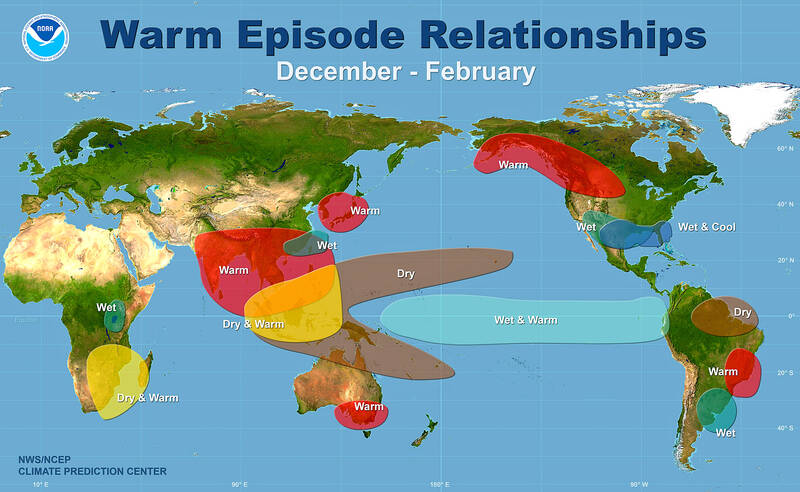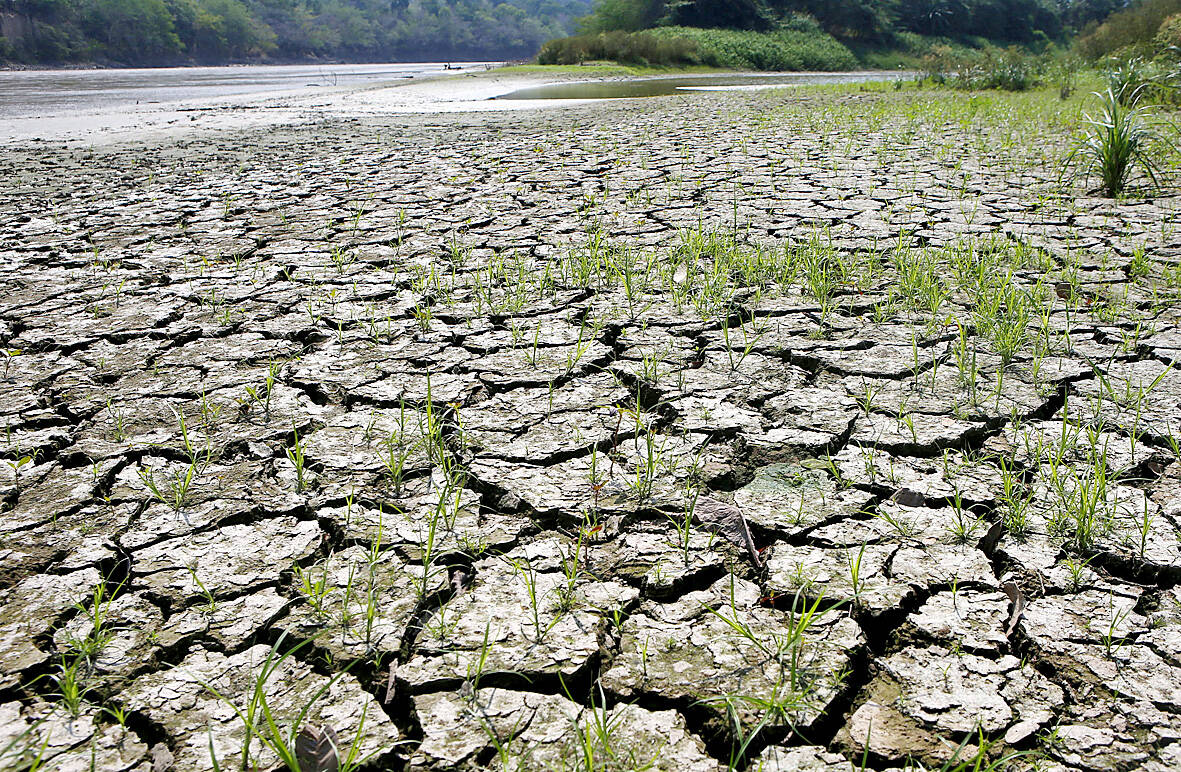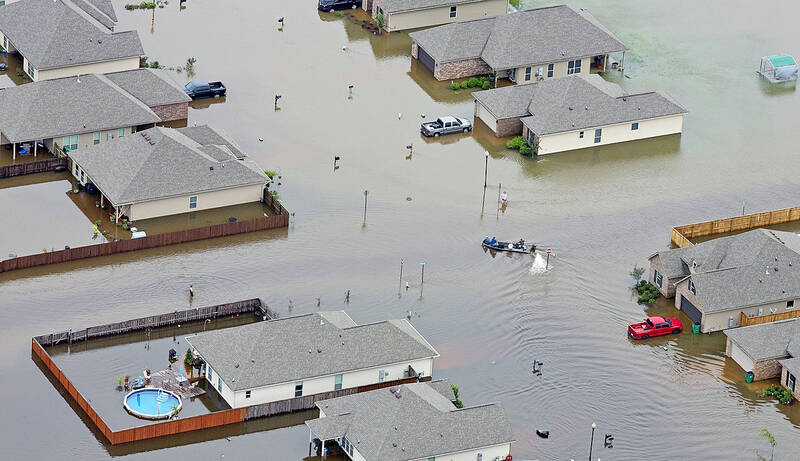Countries are racing to prepare for extreme weather later this year as the world tips into an El Nino — a natural climate phenomenon that fuels tropical cyclones in the Pacific and boosts rainfall and flood risk in parts of the Americas and elsewhere.
On June 8, the US National Oceanic and Atmospheric Administration (NOAA) declared that an El Nino is now underway. The past three years have been dominated by the cooler La Nina pattern.
Scientists say this year looks particularly worrying. The last time a strong El Nino was in full swing, in 2016, the world saw its hottest year on record. Meteorologists expect that this El Nino, coupled with excess warming from climate change, will see the world grapple with record-high temperatures.

Photo: Wikimedia Commons 照片:維基共享資源
WHAT CAUSES AN EL NINO?
El Nino is a natural climate pattern born out of unusually warm waters in the eastern Pacific. It forms when the trade winds blowing east to west along the equatorial Pacific slow down or reverse as air pressure changes, although scientists are not entirely sure what kicks off the cycle.
Because the trade winds affect the sun-warmed surface waters, a weakening causes these warm western Pacific waters to slosh back into the colder central and eastern Pacific basins.

Photo: Reuters 照片:路透
During the 2015-16 El Nino — the strongest such event on record — anchovy stocks off the coast of Peru crashed amid this warm water incursion, and nearly a third of the corals on Australia’s Great Barrier Reef died. In too-warm waters, corals will expel living algae, causing them to calcify and turn white.
This buildup of warm water in the eastern Pacific also transfers heat high into the atmosphere through convection, generating thunderstorms.
HOW DOES EL NINO AFFECT THE WORLD’S WEATHER?

Photo: AP 照片:美聯社
This shift in storm activity affects the current of fast-flowing air that moves weather around the world — called the subtropical jet stream — pushing its path southward and straightening it out into a flatter stream that delivers similar weather along the same latitudes.
During an El Nino, the southern US experiences cooler and wetter weather, while parts of the western US and Canada are warmer and drier.
Hurricane activity falters as the storms fail to form in the Atlantic due to changes in the wind, sparing the US, but tropical cyclones in the Pacific get a boost, with storms often spinning toward vulnerable islands.
Some parts of Central and South America experience heavy rainfall, although the Amazon rainforest tends to suffer from drier conditions.
Meanwhile, Australia endures extreme heat, drought and bushfires.
El Nino could offer a reprieve to the Horn of Africa, which has recently suffered five consecutive failed rainy seasons. El Nino brings more rain to the Horn, unlike the triple-dip La Nina, which desiccated the region.
Historically, both El Nino and La Nina have occurred about every two to seven years on average, with El Nino lasting nine to 12 months. La Nina, which takes hold when waters are cooler in the eastern Pacific, can last one to three years.
IS CLIMATE CHANGE AFFECTING EL NINO?
Scientists are not sure whether climate change will shift the balance between El Nino and La Nina, making one pattern more or less frequent. If ocean temperatures are rising across the board, it is unlikely that the cycle would change, scientists said, as the basic mechanics behind the phenomenon stay the same.
However, if some parts of the ocean are warming faster than others, that could influence how El Nino plays out by amplifying temperature differences.
(Reuters)
世界進入聖嬰現象,各國也競相為今年稍晚的極端天氣做好準備。聖嬰現象是一種自然氣候現象,會加劇太平洋的熱帶氣旋,並使美洲部分地區及其他地方的降雨和洪水風險增加。
美國國家海洋暨大氣總署(NOAA)六月八日宣布,聖嬰現象正在發生。過去三年一直是以較冷的反聖嬰現象模式為主。
科學家說今年看來特別令人擔憂。上次強烈聖嬰現象全面爆發是在2016年,是全球有史以來最熱的一年。氣象學家預估,此次的聖嬰現象,加上氣候變化導致的過度暖化,會全球溫度與創紀錄的高溫有得比。
聖嬰現象的成因為何?
聖嬰現象是一種自然氣候模式,源於東太平洋異常溫暖的水域。
沿赤道太平洋由東向西吹的信風隨氣壓變化而減慢或逆轉時,它就會形成,雖然科學家並不完全確定這循環是如何引發的。
由於信風會影響被太陽加熱的表層海水,信風的減弱會使這些溫暖的西太平洋海水重新流入較冷的中太平洋與東太平洋盆地。
在2015-16年的聖嬰現象(有記錄以來最強烈的聖嬰現象)期間,秘魯沿海的鯷魚類魚群因這次暖水入侵而數量暴減。澳洲大堡礁近三分之一的珊瑚死亡。若海水太暖,珊瑚會將活藻排出,導致珊瑚鈣化且變白。
東太平洋暖水的聚集,還會透過對流將熱傳遞到高空大氣中,而產生雷暴。
聖嬰現象如何影響全球天氣?
風暴活動的這種轉變影響了形塑世界各地天氣的快速流動之氣流——稱為亞熱帶噴射氣流——將其路徑向南推,並將它拉直成一條更平坦的氣流,在相同的緯度上形成類似的天氣。
聖嬰現象期間,美國南部的天氣會更涼爽、更潮濕,而美國西部與加拿大部分地區則更溫暖及乾燥。
由於風的變化,風暴無法在大西洋形成,颶風活動減弱,讓美國倖免於難。但太平洋的熱帶氣旋卻得到加強,風暴常旋轉著撲向脆弱的島嶼。
中美洲及南美洲的一些地區會有強降雨,雖然這時亞馬遜熱帶雨林常是受乾旱之苦。
澳洲所經受的則是極端高溫、乾旱與叢林大火。
聖嬰現象可能會給非洲東北部的「非洲之角」帶來喘息的機會,非洲之角近年連續五個雨季都沒下雨。聖嬰現象給非洲之角帶來了更多降雨,這與使該地區變得乾燥的連續三次反聖嬰現象不同。
由歷史看來,聖嬰現象和反聖嬰現象平均每兩年到七年發生一次,聖嬰現象持續九到十二個月。當東太平洋水域變冷時,反聖嬰現象可持續一至三年。
氣候變化會影響聖嬰現象嗎?
科學家並不確定氣候變化是否會改變聖嬰現象和反聖嬰現象之間的平衡,使其中一種模式較常或較少出現。科學家表示,若海洋溫度全面上升,則此周期不太可能改變,因為這種現象背後的基本機制並未改變。
然而,若海洋某些部分比其他地方暖化得更快,變大的溫差可能會影響聖嬰現象的開展。
(台北時報林俐凱編譯)

As the priest Antonius Hambroek stood in the dim chamber of Fort Zeelandia, his eldest daughter clung to him, her voice trembling. “Father, don’t go. They’ll kill you, and what will become of Mother and my sisters?” Outside, the sounds of Koxinga’s relentless canon siege boomed through the fortress. The defenders were on the brink of collapse. Starvation gnawed at their resolve, and the air carried the acrid stench of spent gunpowder and rotting flesh. Dutch reinforcements from Batavia had failed to arrive, leaving the garrison isolated and hopeless. Hambroek’s face was calm, though sorrow weighed heavily on his

As we bundle up in thick coats to stay warm during the winter, there is a population that has already adapted to extremely low temperatures. These people live in the remote city of Yakutsk, the coldest city on Earth. Yakutsk is situated in the heart of Siberia, which is the capital of the Sakha Republic in Russia. This historic mining city began to flourish in the 19th century following the discovery of gold deposits. Given its construction on permafrost, the average temperature in the city remains below 0°C for over half the year, with winter temperatures dropping to an astonishing -50°C.

The Dutch introduced the Indian mango (Mangifera indica) to Taiwan in the 17th century. It is a green-skinned mango with thick fibers that get stuck in the teeth, but it boasts a rich aroma and a unique taste. In 1954, Taiwan’s Council of Agriculture introduced several mango cultivars from Florida, USA, including the Irwin, Haden, and Keitt varieties. After seven years of testing and domestication, the Irwin variety was chosen for promotion. Years later, the sample saplings started to bear fruit. These mangoes were large, with thin, vibrant red peels and golden pulp. The Irwin mangoes were mouth-wateringly sweet and

對話 Dialogue 清清:今天中午我要多吃一點,不然晚上可能會吃不飽。 Qīngqing: Jīntiān zhōngwǔ wǒ yào duō chī yìdiǎn, bùrán wǎnshàng kěnéng huì chībùbǎo. 華華:怎麼了?為什麼會吃不飽? Huáhua: Zěnmele? Wèishénme huì chībùbǎo? 清清:今天大年初七,是「人日節」,傳統上結了婚的女兒要回家給父母送長壽麵,而且最好是素的,我姐姐會回來,只吃素麵,我應該很快就餓了。 Qīngqing: Jīntiān Dànián chūqī, shì “Rénrì jié,” chuántǒng shàng jiéle hūn de nǚ’ér yào huíjiā gěi fùmǔ sòng chángshòumiàn, érqiě zuìhǎo shì sù de, wǒ jiějie huì huílái, zhǐ chī sùmiàn, wǒ yīnggāi hěn kuài jiù èle. 華華:我還是第一次聽說有「人日節」呢!這是怎麼來的啊? Huáhua: Wǒ háishì dì yī cì tīngshuō yǒu “Rénrì jié” ne! Zhè shì zěnme lái de a? 清清:老一輩的人說,女媧是在第七天造出了「人」,所以今天可說是我們每個人的「生日」呢!生日快樂! Qīngqing: Lǎoyíbèi de rén shuō, Nǚwā shì zài dì qī tiān zào chūle “rén,” suǒyǐ jīntiān kěshuōshì wǒmen měi ge rén de “shēngrì” ne! Shēngrì kuàilè! 華華:你也是啊!欸?那前六天女媧都做了什麼呢? Huáhua: Nǐ yěshì a! Éi? Nà